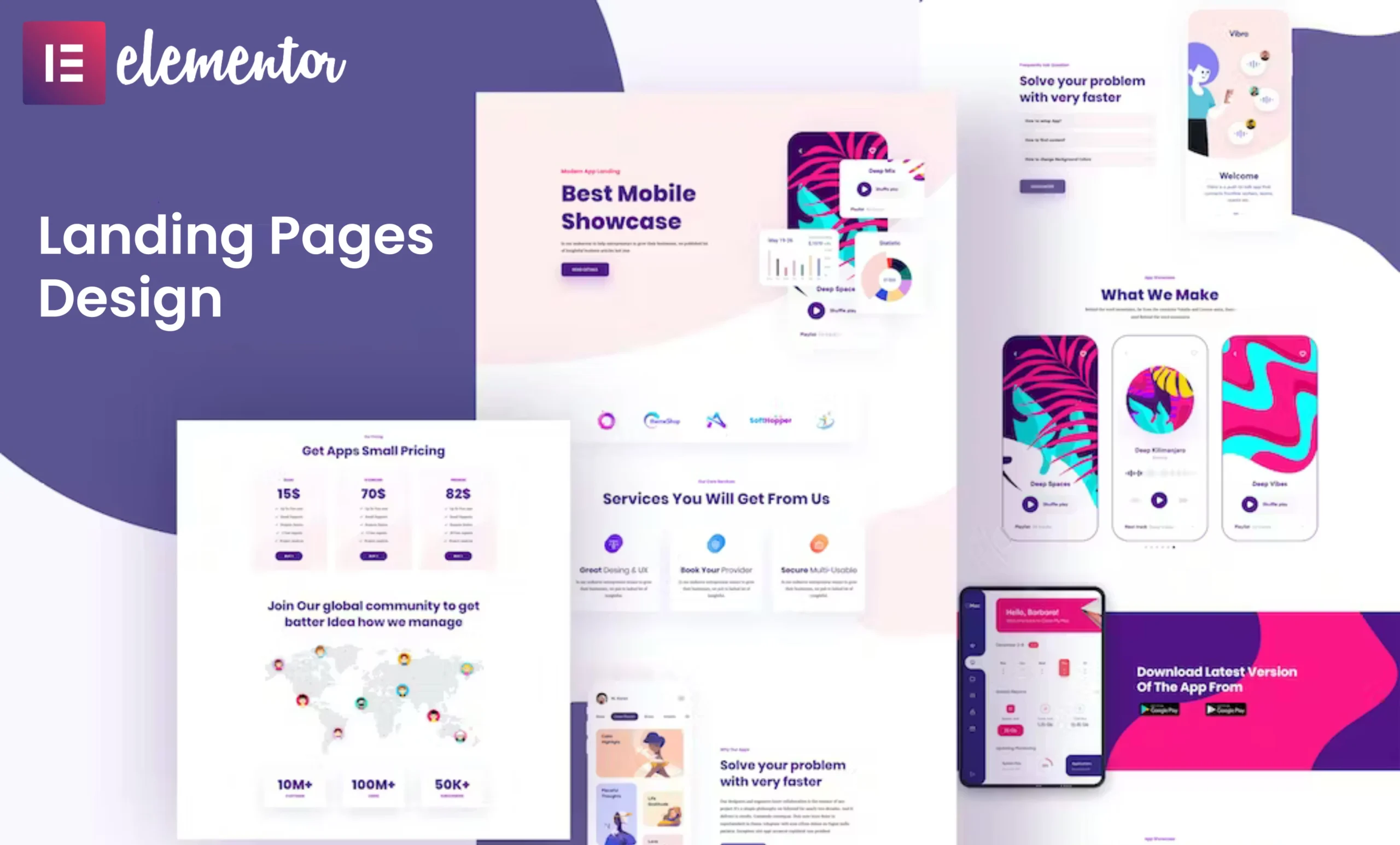
Introduction
In the digital marketing landscape, a well-designed landing page is crucial for converting visitors into leads and customers. Elementor Pro, a popular WordPress page builder, offers powerful features and flexibility to create high-conversion landing pages without requiring coding skills. This article explores the best practices for creating high-conversion landing pages using Elementor Pro, ensuring your pages are both visually appealing and optimized for performance.
Understanding the Importance of High-Conversion Landing Pages
What is a Landing Page?
A landing page is a standalone web page designed specifically for a marketing or advertising campaign. It is where a visitor “lands” after clicking on a link from an email, ad, or other digital sources. The primary goal of a landing page is to convert visitors into leads or customers by encouraging them to take a specific action, such as filling out a form or making a purchase.
Why High Conversion Rates Matter
High conversion rates are indicative of effective landing pages that efficiently turn visitors into valuable leads or customers. Improving conversion rates means better ROI on your marketing efforts and a higher likelihood of achieving your business goals.
Getting Started with Elementor Pro
What is Elementor Pro?
Elementor Pro is a premium WordPress page builder that provides advanced design capabilities and a wide range of widgets and templates. It allows users to create professional-looking landing pages with ease, using a drag-and-drop interface.
Key Features of Elementor Pro
- Drag-and-Drop Editor: Easily design pages without coding.
- Responsive Design: Create pages that look great on all devices.
- Pre-designed Templates: Access a library of customizable templates.
- Advanced Widgets: Utilize various widgets like forms, sliders, and pop-ups.
- Integrations: Seamlessly integrate with marketing tools and services.
Best Practices for Creating High-Conversion Landing Pages
1. Define Your Goal
Importance of a Clear Goal
Every landing page should have a single, clear goal. Whether it’s collecting email addresses, generating sales, or promoting a product, having a focused objective ensures your page is designed to guide visitors towards taking the desired action.
Examples of Landing Page Goals
- Lead Generation: Collecting contact information through forms.
- Sales: Promoting and selling a product or service.
- Event Registration: Encouraging sign-ups for webinars or events.
- Content Download: Offering eBooks or whitepapers in exchange for contact details.
2. Use Compelling Headlines
Crafting Effective Headlines
Your headline is the first thing visitors see, and it needs to grab their attention immediately. A compelling headline clearly conveys the value proposition and encourages visitors to stay on the page.
Tips for Writing Headlines
- Be Clear and Concise: Communicate the main benefit or offer.
- Use Power Words: Words like “Free,” “New,” “Exclusive” can boost engagement.
- Test Variations: A/B test different headlines to see which performs best.
3. Create a Strong Call to Action (CTA)
Importance of a CTA
A strong CTA directs visitors towards taking the desired action. It should be prominent, persuasive, and directly related to the goal of your landing page.
Designing Effective CTAs
- Use Action-Oriented Language: Phrases like “Get Started,” “Download Now,” or “Sign Up Today.”
- Make it Stand Out: Use contrasting colors and bold fonts.
- Keep it Simple: Avoid clutter and ensure the CTA is easy to find.
4. Design for User Experience
Prioritizing User Experience (UX)
A seamless user experience is crucial for high conversion rates. Your landing page should be easy to navigate, visually appealing, and load quickly.
UX Design Tips
- Responsive Design: Ensure your page looks great on all devices.
- Minimalist Layout: Avoid unnecessary elements that can distract visitors.
- Fast Load Times: Optimize images and use efficient coding practices to reduce load times.
5. Leverage Social Proof
Building Trust with Social Proof
Social proof, such as testimonials, reviews, and case studies, can significantly boost credibility and persuade visitors to convert.
Types of Social Proof
- Customer Testimonials: Quotes from satisfied customers.
- Case Studies: Detailed accounts of how your product or service helped a customer.
- Trust Badges: Certifications, awards, or endorsements.
6. Use High-Quality Visuals
Impact of Visuals on Conversions
High-quality images and videos can enhance the appeal of your landing page and help convey your message more effectively.
Choosing the Right Visuals
- Relevant Images: Use images that support your message and resonate with your audience.
- Professional Quality: Ensure all visuals are high-resolution and professionally designed.
- Videos: Incorporate explainer videos or product demos to engage visitors.
7. Optimize Your Forms
Importance of Form Optimization
Forms are often the main conversion point on a landing page. Optimizing your forms can reduce friction and increase the likelihood of conversions.
Form Optimization Tips
- Keep it Simple: Ask for only essential information to minimize barriers.
- Use Conditional Logic: Show or hide fields based on user responses to keep forms relevant and concise.
- Add Inline Validation: Provide immediate feedback to users as they fill out the form.
Advanced Techniques with Elementor Pro
Using Pop-ups for Increased Engagement
Elementor Pro allows you to create pop-ups that can capture attention and drive conversions without interrupting the user experience.
Effective Pop-up Strategies
- Exit-Intent Pop-ups: Trigger pop-ups when a user is about to leave the page.
- Timed Pop-ups: Display pop-ups after a user has spent a certain amount of time on the page.
- Scroll-Triggered Pop-ups: Show pop-ups after a user scrolls a specific percentage of the page.
A/B Testing with Elementor Pro
A/B testing is essential for optimizing your landing pages. Elementor Pro integrates with tools like Google Optimize to facilitate split testing.
Steps for A/B Testing
- Create Variations: Design different versions of your landing page.
- Set Up the Test: Use A/B testing tools to split traffic between variations.
- Analyze Results: Monitor performance metrics to determine the winning version.
- Implement Changes: Apply insights from testing to continuously improve your landing pages.
Conclusion
Creating high-conversion landing pages with Elementor Pro requires a strategic approach that combines design, user experience, and optimization techniques. By defining clear goals, crafting compelling headlines, designing strong CTAs, and leveraging advanced features like pop-ups and A/B testing, you can maximize the effectiveness of your landing pages and achieve your marketing objectives.
